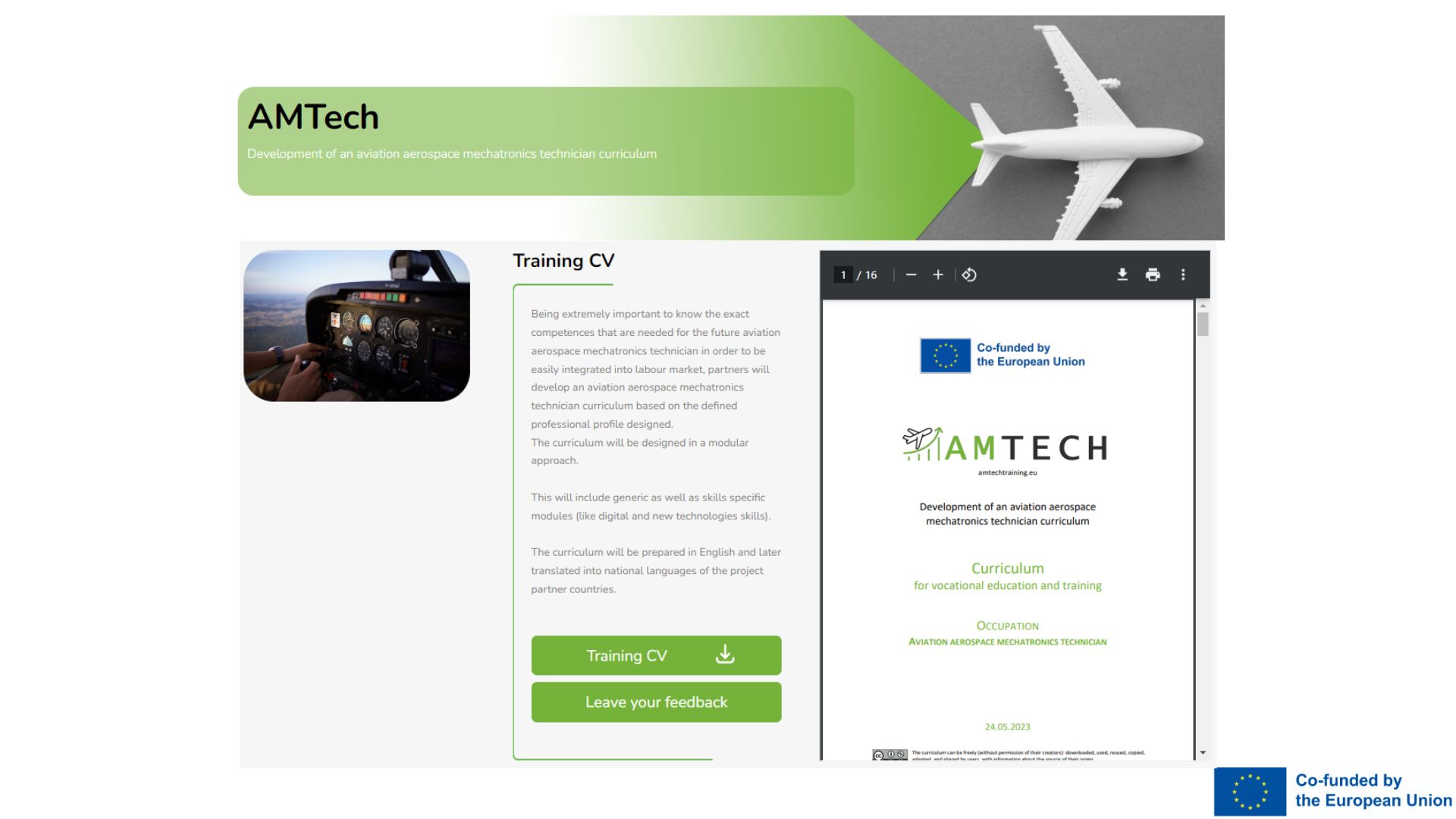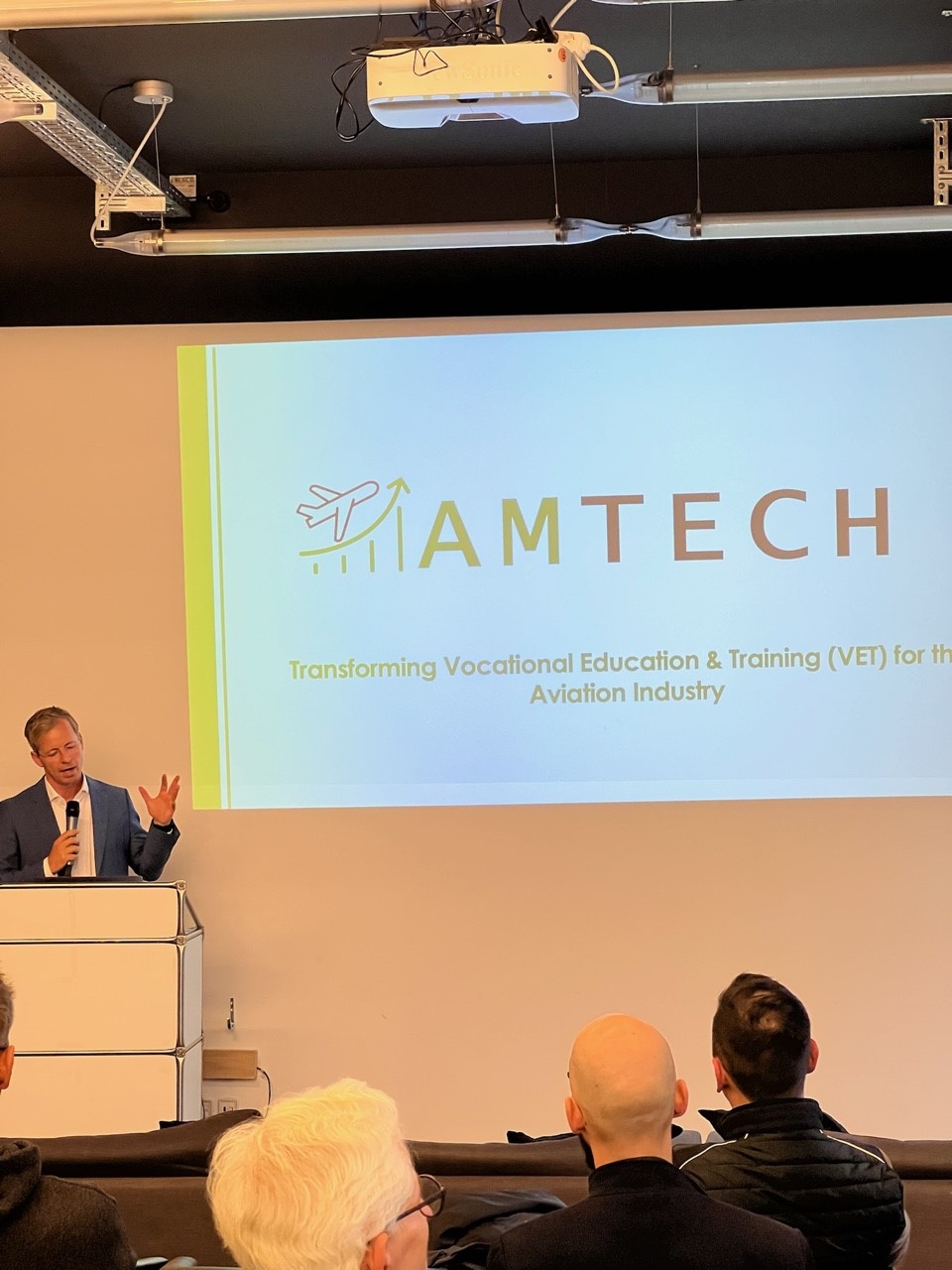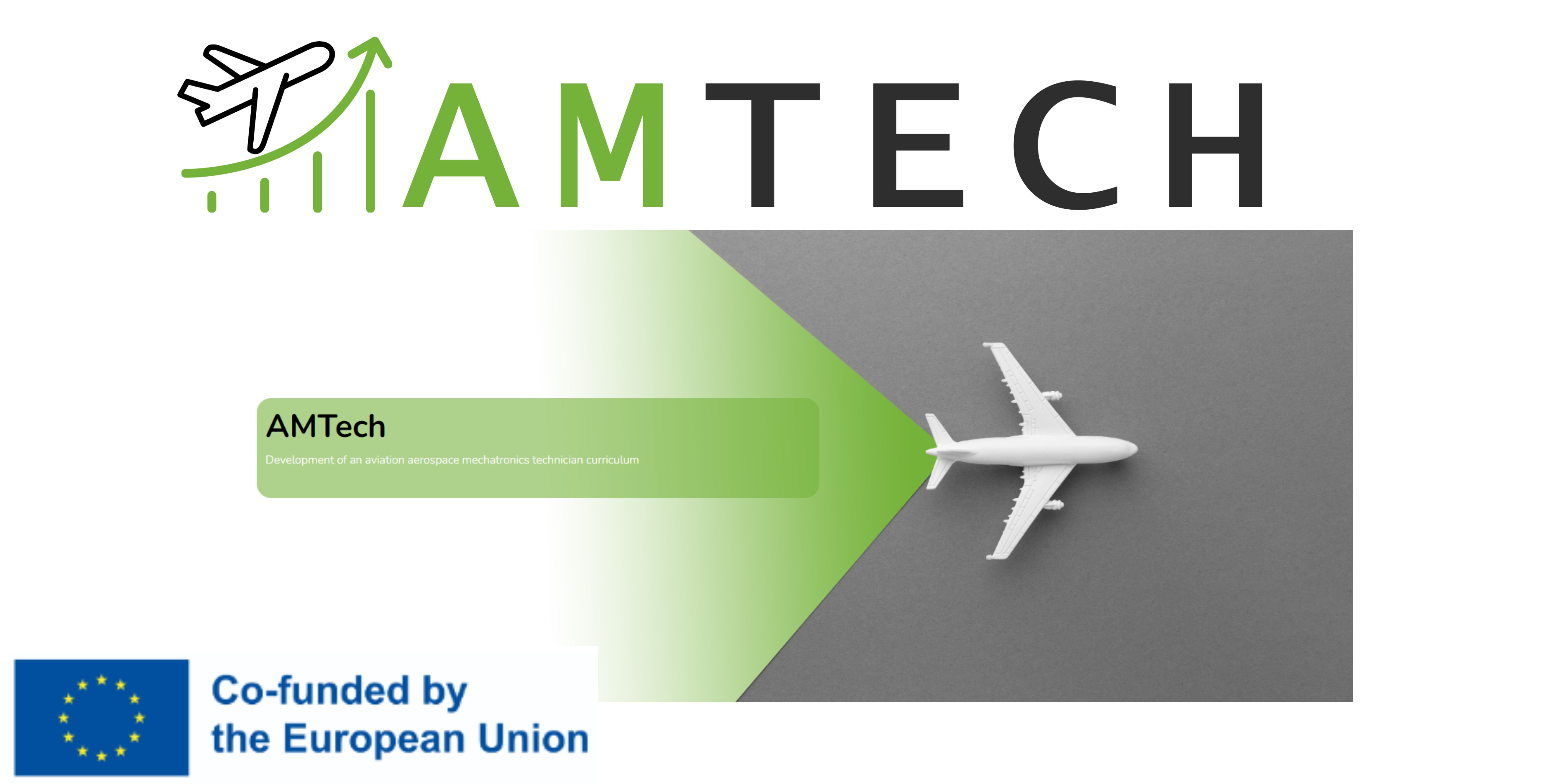






Development of an aviation aerospace mechatronics technician curriculum
.jpg)
On 5 December 2023, a conference was held at the University of Zielona Góra to disseminate the results of the project “AMTech — Development of an aviation aerospace mechatronics technician curriculum”, which was carried out by Elektryk Vocational and Continuing Education Centre (CKZiU Elektryk) in Nowa Sól and other partners under the ERASMUS+ program. First, the project’s subject matter was discussed by teachers involved in its implementation. Ms Katarzyna Gargasiewicz, Ms Katarzyna Pych-Siekierka, and Mr Tomasz Kowalski outlined each phase of the work undertaken in connection with the project, namely an analysis of the aviation industry with a specific focus on drone-related opportunities, an analysis of the labour market in terms of the new qualification, as well as essential and optional knowledge and skills for the role of aviation aerospace mechatronics technician specialising in unmanned aerial vehicles (UAV) and unmanned aerial systems (UAS). Findings of the above analyses were then discussed, and international project partners were briefly introduced. Next came a presentation of how the STEM approach can be used in teaching the main areas of interest addressed by the AMTech project. This included cross-subject learning and using state-of-the-art practical teaching aids in vocational education for technicians. Grzegorz Königsberg, Headteacher at CKZiU Elektryk, told the attending University staff, headteachers, representatives of Nowa Sól District Administrator’s Office and of the Fire Service, University students, and Year 3 and 4 students of Technological Secondary School of Mechatronics about the idea behind the developed aviation aerospace mechatronics technician curriculum, its objectives and content. Mr Königsberg emphasised that this innovative curriculum would provide an opportunity to gain new professional qualifications that responded to an identified demand in the labour market and would close a certain qualifications gap. Those presentations were complemented by a talk given by Dr. Jarosław Gniazdowski, PhD (Eng), Vice Head of the Lubuskie Region Aero Club, researcher at the University of Zielona Góra, and main technical consultant for the AMTeach project, in which he discussed the possibilities of using drones in various branches of the economy. Another important contributor was Dr Marcin Chciuk, PhD (Eng), Assistant Professor at the University of Zielona Góra. Because the University, and specifically the Institute of Mechanical Engineering of the Faculty of Mechanical Engineering, has been closely involved in the AMTech project, Dr. Chciuk presented and discussed a new university course, namely Aviation Engineering with specialisms in Aircraft Mechanics and Unmanned Aircraft Operation. The University is also planning to start a new course — Pilot Studies. Professor Justyna Patalas-Maliszewska, PhD (Eng), Head of the Institute, told the secondary school students that in the future they would be able to use the University’s cutting-edge laboratories and its teaching resources to hopefully become the University’s students one day. The conference finished with a tour of state-of-the-art labs for future aircraft mechanics, and a presentation by the Fire Service of their uses of drones. The event was extensively covered by the media. This included several interviews on Radio Zielona Góra, social media platforms, and websites of both the University and CKZiU Elektryk.

AMTech proudly unveils a groundbreaking achievement in vocational education with the publication of a detailed curriculum designed for aspiring mechatronics technicians in the aviation aerospace industry. This curriculum, a central component of the AMTech project, addresses the identified skills gaps and competences outlined in the earlier transnational need analysis. Developed through collaborative efforts among project partners, the curriculum has undergone rigorous piloting within educational settings, garnering positive feedback from target groups. This achievement marks a significant step towards equipping vocational education and training centers with the resources needed to foster competences and skills essential for the success of future mechatronic technicians in the aviation industry. The AMTech curriculum reflects a balanced mix of vocational skills aligned with emerging job roles and key competences within the aviation sector, providing a comprehensive framework to prepare individuals for fulfilling careers in aviation aerospace mechatronics. The curriculum is structured into four main pedagogical areas: 1.Aviation & Aerospace, education and learning objectives: To provide students with a comprehensive understanding of aviation technology, aircraft maintenance, and repair procedures; to develop the necessary professional competencies required for successful employment as an aircraft technician in the aviation and aerospace industries. 2.Electrical & Mechatronics, education and learning objectives: To equip learners with the necessary knowledge and skills required to maintain, repair and troubleshoot electrical and mechatronic systems in aircraft. The training will enable them to understand and work with various systems such as avionics, power generation, lighting, communication, and navigation systems. 3.Computer Science & Avionics, education and learning objectives: To equip the technicians with the necessary knowledge, skills, and competencies to effectively maintain, repair, and troubleshoot aircraft computer and avionics systems. This training will provide the technicians with the ability to identify, diagnose and resolve issues in avionics systems that use computer-based technologies. 4.Safety & Operations, education and learning objectives: To provide comprehensive training to aircraft technicians in safety and operations, covering all aspects of aircraft maintenance, inspection, repair, and troubleshooting. The curriculum aims to equip technicians the necessary skills and knowledge to ensure the safety and efficiency of aircraft operations, minimize the risk of accidents, and comply with regulatory requirements. The curriculum comes also with six short training modules that complements the content of the aforementioned and can be used by education and training providers as support material of their teaching and lessons. 1. How to deliver digital training content through a digital training platform 2. Useful resources for VET professionals and trainers 3. How to engage students in online training 4. Theoretical training in the drone industry based on STEM subjects in VET education 5. Practical application of STEM in VET: a guide for trainers and students 6. Introduction to UAS Technology and its future landscapes To access all project’s result available and teaching and education material, please consult: www.amtechtraining.eu

AMTech proudly presents the official project result, the European Aviation Aerospace Mechatronics Passport—a transformative tool connecting the AMTech curriculum with essential European frameworks. This passport establishes concrete linkages between the AMTech curriculum, ESCO's occupational profile, skills and competences, EUROPASS, and EURES, ensuring a seamless integration into the broader European context. The passport serves as a valuable resource for individuals seeking recognition of their skills and competences, enhancing employability prospects across European borders. By aligning with established European frameworks, the AMTech project aims to facilitate the mobility of skilled mechatronics technicians within the aviation aerospace industry, fostering a dynamic and interconnected workforce. The development of the first “European Aviation Aerospace Mechatronics Passport – EAAMP”, represents the fourth and final result of the AMTech project – Development of an aviation aerospace mechatronics technician curriculum. The specific content and outline of Project Result 4 (henceforth, PR4) is informed by the evidences and results compiled by partners throughout the previous cycles of project’s implementation: the transnational needs assessment for identification of trends and dynamics in the aviation aerospace industry, and related in-demand competences for employability and professional development in the industry the consolidation of a comprehensive, holistic and systemic VET curriculum addressing the education and training areas of interest to access and operate in the job market(s) of advanced air mobility (AAM), unmanned aerial vehicles (UAV) and unmanned aircraft systems (UAS). Full access to the transnational needs analysis, the curriculum (learning areas of interest, Goals, Professional competences to be achieved and outline of education and training content) and the passport itself, is available via the official OER (Open Education Resource) platform of the project: www.amtechtraining.eu. The content of these document provides for three (3) additional resources: ESCO-compliant profiling of the AM TECH curriculum – extrapolation and benchmarking from the ESCO platform of competences that complements the proposed curriculum and provide for specific descriptors of the associated skills and knowledge. The linkages will allow for greater transparency and transferability of the curriculum in the EU labour market, while setting a common “dictionary” of reference for the qualification at transnational level of this professional profile. EURES-based narrative definition of the new profile and occupation – consolidating the interoperability of the AM TECH’ specialist and its description within the EURES system. The intervention of the project on the EURES dimension allows employers to crystalize the specific terminology bridging the dynamics of supply and demand, and ease the engagement of talents. EUROPASS-standardised description of the AM TECH’ specialist – valorisation and promotion of the AM TECH-inspired professional profile in a standard CV format for jobseeking and employability. Altogether, these three separate deliverables contribute to ease the into-action operationalisation of the AM TECH’ profile, and most importantly, the effectiveness and efficiency of matching dynamics between supply and demand within the relevant job market(s).

SteamUp Education (hosted by DroneMasters Academy - Berlin), in collaboration with industry partners from Belgium, Spain, Germany, Italy, Poland and Latvia, proudly announced the launch of the European Aviation Mechatronics Technician (AMTech) Curriculum. This joint initiative co-sponsored by European Union through the ERASMUS research grant, is set to revolutionize workforce development for the Advanced Air Mobility (AAM), Uncrewed Aerial Vehicle (UAV), and Uncrewed Aircraft Systems (UAS) industries in Europe. The AMTech project is a response to the challenges in keeping up with the pace of rapid advancements in technology and the demands of the modern workforce. In a world marked by continuous technological progress and societal transformation, education and vocational training must adapt to equip individuals of all ages with the skills needed for the jobs of the future. The proposed curriculum represents a groundbreaking initiative aimed at bridging the skills gap in the industry. It was jointly developed by industry leaders who understand the evolving needs of this sector. The objective of the AMTech project was set out to: Upgrade competences and skills of VET learners to be able to find a job in the growing aviation industry. Help VET learners to gain the right skills that Europe can strengthen its position in global competition and have a sustained economic relaunch geared towards a green and digital transition. Identify trends and dynamics in the aviation industry sector and developing a new professional profile of an aviation mechatronics technician (AMTech) in alignment with ESCO through the cooperation between educational institutions and SME and chambers of industry and crafts. Create a new and innovative curriculum of the AMTech specifically designed for labor market needs. Develop the “European Aviation Aerospace Mechatronics Passport – EAAMP” to codify the most relevant profile and occupational features of the new profession by highlighting the competences knowledge and skills required by future aviation industry. At the heart of the AMTech Curriculum is a commitment to lifelong learning, a cornerstone of adapting to the changing employment landscape. The curriculum emphasizes the importance of electrification, autonomy, and sustainability in the aviation and aerospace sector, aligning with the transformative trends outlined in the European Strategy and Policy Analysis System (ESPAS) report on global trends 2030. As global trends shift toward sustainable aviation and drones, the AMTech Curriculum is positioned to play a vital role in shaping the future workforce of the industry. At the inaugural STEAMUP EDUCATION! Conference, industry leaders, educators, and innovators gathered to explore alternative approaches to education and training for the age of transformation. The event was attended by speakers from EASA, Rolls Royce, Pratt & Whitney and Nex Aero to discuss how companies can identify and nurture talent to meet the workforce needs of the future. Innovative strategies like ‘recruitainment’ and the "Scouting & Training" concept, inspired by the world of sports, were discussed. The conference encouraged attendees to look beyond traditional education concepts and create space for continuous learning for individuals of all ages. The AMTech Curriculum aims to bridge the gap between traditional education and the ever-evolving aviation and aerospace industry. By addressing training needs, essential skills, and capacity gaps in electrification, autonomy, and sustainability, it promises to empower a new generation of professionals. SteamUp Education, alongside its European partners, is committed to advancing education and vocational training to meet the needs of the future, promote lifelong learning, and facilitate the growth of a skilled workforce in the AAM, UAV, and UAS industry. Through the development of the AMTech Curriculum, they are pioneering a path towards a brighter and sustainable future.

The Erasmus+ AMTECH (Aviation Aerospace Mechatronics Technician) project working group from Germany, Italy, Belgium, Spain, Latvia and Poland met at the Internet Web Solutions premise, in Málaga to celebrate milestones in transforming Vocational Education. The agenda consisted of insightful presentations and discussions in the areas of analysis of usage of all the Product Results (PR) of AMTECH such as the PR1 - AMTECH OER Platform (OER Platform 24/7 available in 6 languages); PR3 - Development of an AMTech Curriculum and Test&Validation and PR4 - Development of a European Aviation Aerospace Mechatronics Passport. Another important topic discussed during the meeting was the dissemination and communication of all the open educational resources created. Dissemination is crutial to share the outcomes of their research and development activities with other interested parties, ensuring that the acquired knowledge is accessible to a broader audience. This promotes transparency and collaboration in the context of research and innovation. As regards the PR3, the training-related glossary (https://www.amtechtraining.eu/glossary.php ) will help maintaining terminological consistency throughout the training studies. In a European project, there may be students with different mother tongues. The AMTECH multilingual glossary will be helpful in translating key terms uniformly and promoting fairness in access to information. The AMTech project stems from the demand for specific training tailored to the needs of technicians-to-be, microenterprises and SMEs. Throughout this collaboration, partners exchanged experiences and ideas – creating new, innovative or joint Aerospace Mechatronics Technician Curriculum in 6 European languages available at: https://www.amtechtraining.eu/training.php The project, which is co-funded by the European Union via Erasmus+, started the on January 2023 and will proceed until the 31st of January 2024. It aims to bridge the gap between vocational education and the aviation industry's evolving needs, contributing to the economic resurgence of Europe in alignment with green and digital transitions.

AMTech, the pioneering international project aimed at reshaping vocational education in aviation, proudly announces the publication of a comprehensive transnational need analysis focusing on skills and competences crucial for success in the drone sector. This analysis, a significant milestone for the AMTech initiative, sheds light on the specific requirements necessary for individuals to compete, operate, and secure employment in the rapidly evolving drone industry. The need analysis delves into the current gaps in existing professions related to aviation, such as aircraft mechanics and flight equipment engineers, highlighting the critical need for mechatronics and informatics skills. Especially impacting SMEs within the aviation industry, including drone manufacturers, the analysis provides valuable insights into the challenges faced by these enterprises in finding employees with the right skill set and competences. AMTech’s commitment to bridging the skills gap in the drone sector is evident in this detailed transnational need analysis, offering a strategic roadmap for aligning vocational education and training with the dynamic demands of the labor market. Results from the analysis have shown that the industry of unmanned aircraft (aka drones) is expected to represent a powerhouse for the employability, innovation and development of the EU aeronautics industry. Industrial application of drones benefits a wide cohort of sectors (agriculture, energy, public safety, e-commerce, mobility, etc), with significant spill-over effects for entrepreneurs operating within these markets. Despite the great technology advancements observed in the timeframe of the past ten years, further R&D efforts are needed to enhance the value that the drone industry can generate for end users. Most of potential industrial applications are still in an early stage of experimentation, with public opinion still divided on concerns for privacy and safety. The work of regulators is aimed at easing the social acceptance of this new phenomenon, without posing excessive burden to the innovation paths traced by the many new organisations operating in the unmanned aircraft sector. Competitive outlooks for businesses in the drone industry are bright and very promising, but on the other hand the sector might risk of reaming devoid of professional profiles that allow for the great technological effectiveness of this new state of art technology. The analysis carried out in this report is aimed at assessing in a concise and comprehensive format the training needs informing the design, structure and following learning outcomes of the curriculum for aerospace mechatronics technicians. The references extrapolated from literature are somehow indicative of what this curriculum should look like at VET level, what could be the knowledge and skills detained by such professional profile, etc. but most of the effort was invested into interpreting and decoding data so as to shape an archetype that is still in the making. Data and resources collected allowed us to systemize an ideal curricula framework for drone maintenance-related operations that could fit indeed the professional profile seek by this project, and the needs of training and education providers. To access the full report an other resources generated by AMTech’s partners, please visit: www.amtechtraining.eu

The AMTECH OER platform is now online in six languages at https://www.amtechtraining.eu/, providing specific info on project aims, activities and results. The Platform will contain all the Project information, deliverables and outcomes. AMTECH's General Objective is to adapt vocational education and training to labour market needs by: • Upgrading competences and skills of VET learners to be able to find a job in the growing aviation industry sector • Helping VET learners to gain the right skills so that Europe can strengthen its position in global competition and have a sustained economic relaunch geared toward a green and digital transition • Identifying trends and dynamics in the aviation industry sector and developing a new professional profile of an aviation aerospace mechatronics technician (AMTech) in alignment with ESCO through the cooperation between educational institutions and SMEs and chambers of industry and crafts • Creating a new and innovative curriculum of the AMTech designed explicitly for labour market needs • Developing the "European Aviation Aerospace Mechatronics Passport – EAAMP" to codify the new profession's most relevant profile and occupational features, highlighting the competencies, knowledge and skills required. Moreover, the AMTech project requires and produces European added value: 1. Materialize the transnational confrontation and exchange between different VET realities. AMTech brings together countries that have a strong connotation of SME and can each contribute significantly to creating a European product thanks to the diversity of the partners representing different approaches to the same challenge 2. The diversity of the organizations represented amplifies the cross-border dimension of AMTech: VET providers (in different environments and contexts), SME as well as SME support organizations 3. The diversity above materializes in a truly cross-border and transnational dimension allowing AMTech to broker the exchange from and between different realities, methodologies, working mechanisms and entrepreneurship models. The accessible and user-friendly Platform has been built by the Spanish partner, IWS (Internet Web Solutions) and will be constantly updated by the partnership as a whole during the project implementation. AMTECH OER Platform is available in six languages (English, Spanish, Polish, Italian, German and Latvian) and is composed of the following sections freely available to all navigators. • PROJECT: describes the main Project objectives and results. • PARTNERS: describes the Partners involved in the AMTECH Project. • ANALYSIS: The project partners will research industry trends and dynamics to define the professional profile of an AMTECH, qualifications, and skills set needed and align it with ESCO references. • TRAINING CV: partners will develop an aviation aerospace mechatronics technician curriculum based on the defined professional profile designed • PASSPORT: Partners will develop the first "European Aviation Aerospace Mechatronics Passport – EAAMP" by extrapolating the professional profile defined and benchmarking it against the ESCO profiles most relevant to this innovative profile. • COMMUNITY: to involve as many Associated Partners as possible and spread the word about • NEWS: to remain continuously updated with AMTECH's latest developments AMTECH is managed by seven partners from five countries, i.e. Italy, Spain, Belgium, Latvia, Germany, and Poland, and is co-financed by the Erasmus+ Programme of the European Commission.


Copyright © All rights reserved | AMTech
